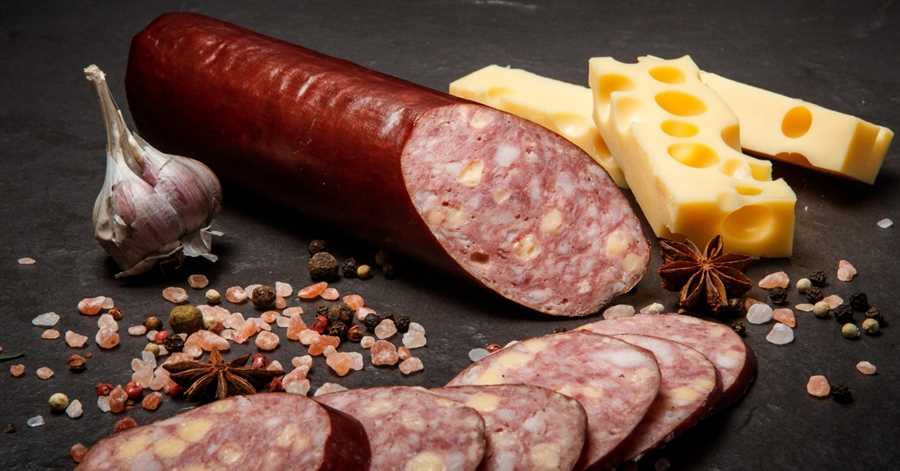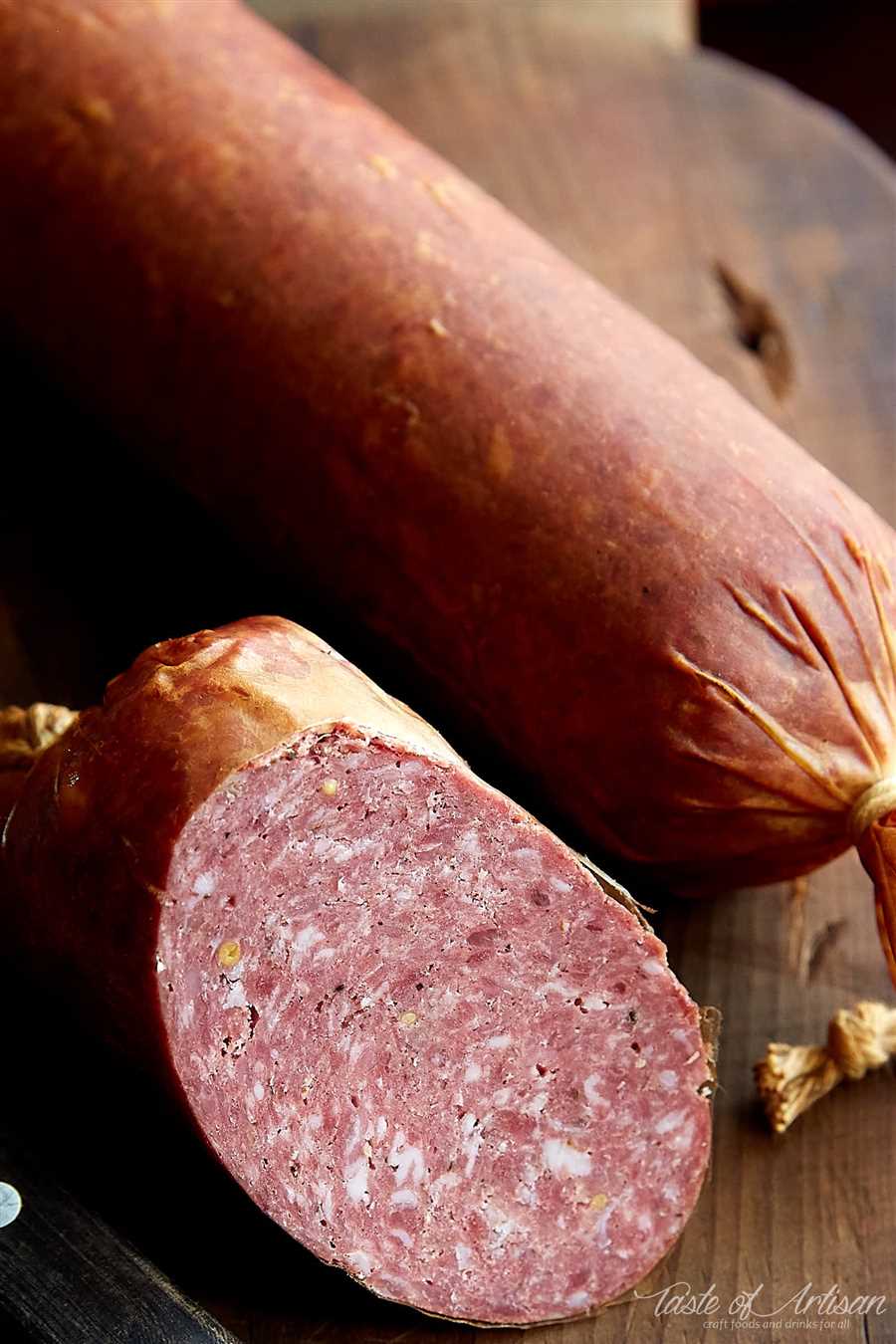







Summer sausage is a popular cured sausage that is often enjoyed during the summer months. It is a versatile sausage that can be eaten cold or cooked, depending on personal preference. However, it is important to understand the proper way to handle and prepare summer sausage to ensure food safety.
Contrary to its name, summer sausage does not require cooking. It is a type of sausage that is fermented and dried, which means it is safe to eat without any additional cooking. The curing process of summer sausage involves adding salt, nitrates/nitrites, and other seasonings to the meat mixture, which helps to preserve it and give it a distinctive flavor.
That being said, many people choose to cook their summer sausage before eating it. Cooking summer sausage can enhance the flavors and alter the texture, making it a delicious option for those who prefer a cooked sausage. Some common methods of cooking summer sausage include grilling, baking, or pan-frying.
Whether you decide to eat your summer sausage cold or cooked, it is important to handle it properly to prevent any potential foodborne illnesses. Make sure to store summer sausage in the refrigerator and consume it before the expiration date. Additionally, always wash your hands and utensils thoroughly before and after handling any raw or cooked meat products.
In conclusion, while summer sausage does not need to be cooked, you have the option to cook it if you prefer. Whether you enjoy it cold or cooked, summer sausage is a delicious and versatile sausage that can be enjoyed in a variety of ways.
Benefits of Cooking Summer Sausage
Cooking summer sausage offers numerous benefits that enhance both the taste and safety of the sausage. By cooking summer sausage, you can unlock its full potential and enjoy it in various delicious ways.
Improved Flavor
Cooking summer sausage enhances its flavor profile. The process of cooking helps to release the natural juices and flavors, resulting in a richer taste. The combination of heat and cooking time allows the spices and seasonings to meld together, creating a well-balanced and delicious flavor.
Additionally, cooking summer sausage can offer the opportunity to add extra flavors. Grilling or baking the sausage allows you to infuse it with smoky or charred notes, adding complexity to the taste. You can experiment with different cooking methods to achieve the desired flavor profile.
Food Safety
Another significant benefit of cooking summer sausage is improved food safety. Summer sausage is a type of cured sausage that typically does not require cooking due to the curing process. However, cooking the sausage can provide an additional layer of safety.
Cooking summer sausage helps to eliminate any potential bacteria or pathogens that may be present. Heating the sausage to the appropriate temperature ensures that it is safe to consume. This is especially crucial if you are serving summer sausage to individuals with weakened immune systems, such as young children or elderly individuals.
Furthermore, cooking summer sausage can help to eliminate excess fat and grease, reducing the risk of potential health concerns. By cooking the sausage and allowing the fat to render out, you can enjoy a leaner and healthier sausage.
In conclusion, cooking summer sausage not only enhances its flavor but also improves its safety. Whether you choose to grill, bake, or cook summer sausage in other ways, you can enjoy a tastier and safer product. Remember to always follow proper cooking guidelines and ensure that the sausage reaches the appropriate temperature to guarantee safety.
Enhanced Flavor and Aroma
Summer sausage is a flavorful and aromatic sausage that is commonly enjoyed during the summer months. The process of cooking summer sausage enhances its flavor and aroma, bringing out the best in this delicious cured meat.
Seasonings
One of the key factors that contribute to the enhanced flavor and aroma of summer sausage is the blend of seasonings used during the cooking process. Traditional summer sausage recipes often include a combination of salt, black pepper, garlic powder, mustard seeds, and other herbs and spices. These seasonings infuse the meat with a rich and savory flavor, while also adding a pleasant aroma that entices the senses.
The seasonings are typically mixed into the ground meat mixture before it is stuffed into casings. This allows the flavors to meld together and marinate the meat, resulting in a more intense and complex taste.
Smoking

Another step that contributes to the enhanced flavor and aroma of summer sausage is smoking. After the sausage is stuffed into casings, it is commonly smoked to add a smoky, woody flavor to the meat. The smoking process also helps to further preserve the sausage and give it a longer shelf life.
Traditionally, summer sausage is smoked using hardwood chips such as hickory or maple. The wood chips are soaked in water before being placed in a smoker, which creates a fragrant smoke that infuses the sausage with a delightful smoky aroma.
The smoking process not only adds flavor and aroma but also imparts a beautiful color to the sausage. The smoke creates a golden brown or deep red exterior, adding to the visual appeal of the sausage.
Conclusion
The cooking process of summer sausage plays a vital role in enhancing its flavor and aroma. By using a combination of flavorful seasonings and smoking with hardwood chips, summer sausage becomes a delectable treat that is both savory and aromatic. Whether enjoyed on its own or as part of a charcuterie board, summer sausage is a delightful addition to any summer gathering.
Improved Food Safety
In recent years, there has been a growing concern about food safety in the production and preparation of various food items. This concern extends to summer sausage as well. To ensure that summer sausage is safe to consume, certain measures need to be taken.
Storage
Proper storage is crucial for maintaining the safety of summer sausage. It is important to store the sausage in a cool environment, such as a refrigerator, to prevent the growth of harmful bacteria. Additionally, the sausage should be stored separately from other foods to prevent cross-contamination.
Cooking
Although summer sausage is a cured meat and can be enjoyed without cooking, it is recommended to cook it to enhance its flavor and improve its safety. Cooking summer sausage at a temperature of 160°F (71°C) ensures that any potential bacteria are killed, making it safe to consume.
Note: While cooking summer sausage is not necessary for safety reasons, it is advisable to do so to minimize any potential risks.
Handling
Proper handling practices are essential to maintain food safety while working with summer sausage. It is crucial to wash hands thoroughly before and after handling the sausage to prevent the spread of bacteria. Utensils and surfaces should also be cleaned and sanitized properly.
Remember: Following these guidelines will help ensure that summer sausage is safe to consume and minimize the risk of foodborne illnesses.
Customized Seasonings and Ingredients
One of the great advantages of making your own summer sausage is the ability to customize the seasonings and ingredients to your preference. Whether you like it spicy or mild, you have the freedom to choose the level of heat and flavors you want in your sausage. You can experiment with different combinations of spices, herbs, and other seasonings to create a unique and delicious summer sausage.
Furthermore, you have control over the quality of ingredients used in your homemade summer sausage. You can select fresh, high-quality meats and ensure that they are free from any additives or preservatives. This allows you to make a healthier version of summer sausage, as you can avoid any unnecessary fillers and chemicals that are often found in store-bought sausages.
Additionally, by making your own summer sausage, you can cater to specific dietary restrictions or preferences. For example, if you or someone in your family is allergic to certain ingredients, you can easily omit or substitute them in your homemade sausage. This way, you can enjoy a summer sausage that meets your dietary needs and still tastes delicious.
Overall, making your own summer sausage gives you the freedom to create a customized and flavorful sausage that suits your individual taste buds and dietary requirements. So why not try your hand at making homemade summer sausage and unleash your creativity in the kitchen?
Increased Shelf Life

One of the benefits of cooking summer sausage is the increased shelf life it provides. Summer sausage is a type of sausage that is typically cured and smoked, which helps to extend its storage time. When summer sausage is properly cooked and stored, it can last for several weeks or even months.
Cooking summer sausage helps to eliminate any potential bacteria or pathogens that may be present in the meat. The high cooking temperature kills off these microorganisms, reducing the risk of spoilage. Additionally, the cooking process helps to seal in the flavors and juices of the sausage, preventing it from drying out and becoming less palatable.
Proper storage is also essential in maintaining the extended shelf life of cooked summer sausage. It should be refrigerated or stored in a cool, dry place to prevent the growth of bacteria. Vacuum-sealing or using airtight containers can further help to protect the sausage from exposure to air, which can cause spoilage.
Overall, cooking summer sausage not only enhances its taste and texture but also ensures its safety and longevity. By properly cooking and storing summer sausage, you can enjoy this delicious meat product for an extended period, making it a convenient and versatile food option.
Questions and answers
Is it necessary to cook summer sausage?
Yes, summer sausage needs to be cooked before consumption to ensure it is safe to eat.
Can I eat summer sausage without cooking it?
No, it is not recommended to eat summer sausage without cooking it first, as it may contain harmful bacteria.
What temperature should summer sausage be cooked at?
Summer sausage should be cooked at an internal temperature of 160°F (71°C) to ensure it is fully cooked and safe to eat.
How long does summer sausage need to cook for?
Summer sausage typically needs to cook for about 1 to 1.5 hours, depending on its size and thickness.
What are the risks of eating raw summer sausage?
Eating raw summer sausage can pose a risk of foodborne illnesses, such as salmonella or E. coli infections, which can cause severe symptoms like vomiting, diarrhea, and abdominal pain.
What is summer sausage?
Summer sausage is a type of sausage that is typically made from a mixture of ground meat, such as beef or pork, along with spices and seasonings. It is usually cured and smoked, giving it a distinct flavor and a longer shelf life.
Do you need to cook summer sausage?
No, summer sausage is typically ready to eat and does not require cooking. It is usually fully cooked during the curing and smoking process. However, some people may prefer to heat it slightly before consuming for a different texture or flavor.










